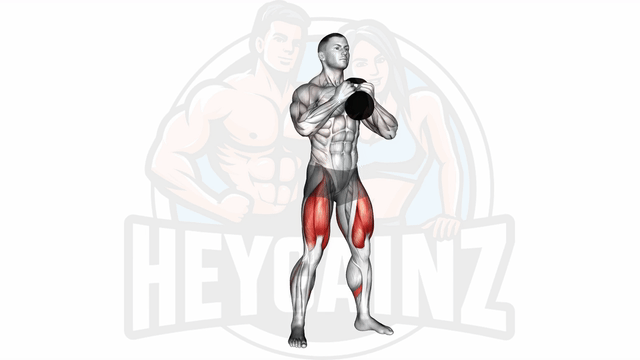
Instructions:
- 1Stand with your feet wider than shoulder width apart, toes pointed outward
- 2Grip the kettlebell by the handle, holding it at your chest
- 3Lower your body into a squat by sending your hips back, keeping your chest lifted
- 4Bend your knees until your thighs are parallel to the ground
- 5Return to the starting position by pushing through your heels
Tips:
- Engage your core throughout the exercise
- Keep your chest lifted during the squat, avoid rounding the back
- Push through your heels on the way up to better engage the glutes
- Inhale as you lower into the squat, exhale as you rise up
Kettlebell Goblet Squat: Benefits and Techniques
The kettlebell goblet squat is a versatile and effective exercise primarily targeting the gluteus maximus and quadriceps. This dynamic movement not only enhances strength but also promotes mobility and balance. Whether you're a novice or an experienced lifter, incorporating the kettlebell goblet squat into your routine can lead to significant improvements in overall fitness.
Benefits of the Kettlebell Goblet Squat
- Full-Body Engagement: This exercise engages multiple muscle groups, making it excellent for strength training.
- Improved Form: Holding the kettlebell at chest level encourages proper squat mechanics, reducing the risk of injury.
- Flexibility and Balance: Regular practice enhances core stability and lower body flexibility.
Muscles Worked
During the kettlebell goblet squat, several key muscle groups are activated:
- Gluteus Maximus: The primary mover responsible for hip extension.
- Quadriceps: Essential for knee extension during the squat.
- Core Muscles: Assist in stabilizing the body throughout the movement.
Proper Form for Optimal Results
Maintaining proper form is crucial for maximizing the benefits of the kettlebell goblet squat and minimizing the risk of injury. Follow these tips to ensure correct execution:
- Start Position: Stand with your feet shoulder-width apart, holding the kettlebell by the handles close to your chest.
- Descending Phase: Initiate the squat by bending at the hips and knees, keeping your chest up and elbows inside your knees.
- Ascending Phase: Push through your heels to return to standing, squeezing your glutes at the top of the movement.
Variations to Explore
To further challenge yourself or target specific areas, consider these variations of the kettlebell goblet squat:
- Kettlebell Goblet Squat to Press: Transition from the squat into an overhead press for added intensity.
- Kettlebell Goblet Squat to Overhead Press: This combination not only builds lower body strength but also incorporates shoulder engagement.
- Weighted Variations: Increase the kettlebell weight to enhance strength gains over time.
Kettlebell Goblet Squat vs Regular Squat
When comparing the kettlebell goblet squat to a traditional squat, the kettlebell variation places more emphasis on upper body posture and core stability, making it a great choice for those looking to improve their overall squat form. Additionally, it allows for a more controlled movement, which can be beneficial for beginners.
Incorporating the kettlebell goblet squat into your workout routine can yield significant benefits, improving both strength and overall fitness. Whether you choose to perform it as a standalone exercise or integrate it into a larger strength training program, the kettlebell goblet squat is a powerful addition to any fitness regimen.